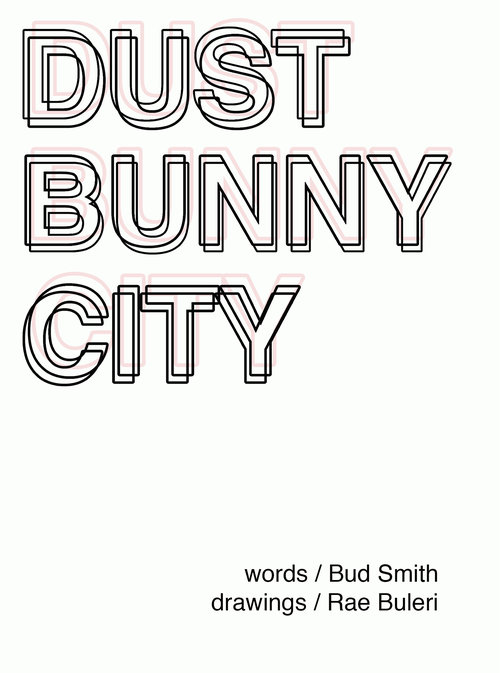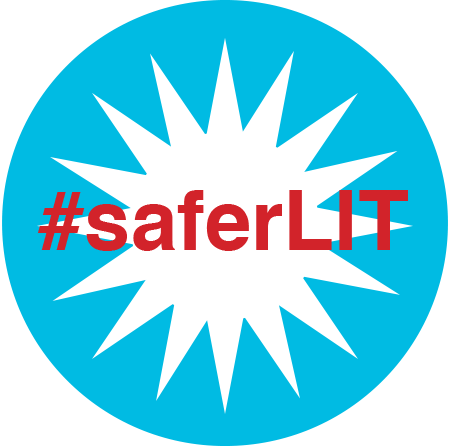ISSN: 1941-4137
POETRY THAT ENACTS THE ARTISTIC AND CREATIVE PURITY OF GLASS
POETRY THAT ENACTS THE ARTISTIC AND CREATIVE PURITY OF GLASS

Aaron Davis got a degree in literature, so he became a chef. He drinks a lot of beer and makes some occasionally and he loves his fiancee dearly.
May 23, 2017
Edited by Stephanie Kaylor
Edited by Stephanie Kaylor
Review of Dust Bunny City by Bud Smith
 Dust Bunny City
by Bud Smith (drawings by Rae Buleri)
Disorder Press, 2017
Bud Smith's Dust Bunny City is a peculiar sort of rapture. To read it is to need to be drunk — literally, of course, and preferably on beer, until the elephants are in hailing distance, and figuratively too, as only someone who is deeply, deeply in love can understand the real meaning of that cliché. It's pretty good, is what I'm trying to say here.
This is a book in two parts. The first, "Tic-Tac-Toe," is an establishing shot of who Smith is — an adoring aesthete who works in a refinery for some reason. We all need to make a buck. The second, "Orange Peel," is a brutal paen to love and loneliness when his wife is away. All of this, and an odor of stale beer and the gritty grime of the eponymous City gnawing at the edges of the bubble he has invited us into.
This is a playfully composed work, told in three media. There's some short form prose — spare and lithe, occasionally to the point of confusion. The confusion is understandable, of course, because it's clear that Smith's calling is as a poet in the modern style. There's nary a rhyme, the rumor of a meter, and dammit it works like a symphony. Where the prose falters in clarity the poetry takes up the torch and, though dense, conveys a deep and abiding love for the minutiae of life — homecoming sex, drunken nights, a pathetic dog who can't go for walks without overheating. This is all illustrated throughout by his talented minimalist of a sketch artist wife, Rae Buleri, whose drawings call to mind Roald Dahl's spastic line drawings. I grew up on Roald Dahl's spastic line drawings, and I love them.
One cannot read this without noticing the (one must assume intentionally) limited vocabulary Smith uses throughout. It comes across as fairly obvious that he's attempting to establish a motif with his repeated mention of elephants and tulip trees, balloons and meteors, but without an explicitly communicated significance, it comes across at first as whimsical for the sake of whimsy and later as thematic for the sake of beating the reader over the head with a hammer full of whimsical themes.
But what are you going to do, really? Some people enjoy elephants, meteors and the like. And this work is for them, I suppose. It's for everyone else, too: if you've ever been in love, if you've ever been hammered on the train, trying to find your way home, and your partner is even more hammered than you are, this is your book. And if you've ever kissed their picture, "in the gold frame, on the dresser by the door," or looked up for fire on every world, this is your book. And if you haven't, this one will make you want to.
Visit Bud Smith's Website
Visit Disorder Press' Website
Dust Bunny City
by Bud Smith (drawings by Rae Buleri)
Disorder Press, 2017
Bud Smith's Dust Bunny City is a peculiar sort of rapture. To read it is to need to be drunk — literally, of course, and preferably on beer, until the elephants are in hailing distance, and figuratively too, as only someone who is deeply, deeply in love can understand the real meaning of that cliché. It's pretty good, is what I'm trying to say here.
This is a book in two parts. The first, "Tic-Tac-Toe," is an establishing shot of who Smith is — an adoring aesthete who works in a refinery for some reason. We all need to make a buck. The second, "Orange Peel," is a brutal paen to love and loneliness when his wife is away. All of this, and an odor of stale beer and the gritty grime of the eponymous City gnawing at the edges of the bubble he has invited us into.
This is a playfully composed work, told in three media. There's some short form prose — spare and lithe, occasionally to the point of confusion. The confusion is understandable, of course, because it's clear that Smith's calling is as a poet in the modern style. There's nary a rhyme, the rumor of a meter, and dammit it works like a symphony. Where the prose falters in clarity the poetry takes up the torch and, though dense, conveys a deep and abiding love for the minutiae of life — homecoming sex, drunken nights, a pathetic dog who can't go for walks without overheating. This is all illustrated throughout by his talented minimalist of a sketch artist wife, Rae Buleri, whose drawings call to mind Roald Dahl's spastic line drawings. I grew up on Roald Dahl's spastic line drawings, and I love them.
One cannot read this without noticing the (one must assume intentionally) limited vocabulary Smith uses throughout. It comes across as fairly obvious that he's attempting to establish a motif with his repeated mention of elephants and tulip trees, balloons and meteors, but without an explicitly communicated significance, it comes across at first as whimsical for the sake of whimsy and later as thematic for the sake of beating the reader over the head with a hammer full of whimsical themes.
But what are you going to do, really? Some people enjoy elephants, meteors and the like. And this work is for them, I suppose. It's for everyone else, too: if you've ever been in love, if you've ever been hammered on the train, trying to find your way home, and your partner is even more hammered than you are, this is your book. And if you've ever kissed their picture, "in the gold frame, on the dresser by the door," or looked up for fire on every world, this is your book. And if you haven't, this one will make you want to.
Visit Bud Smith's Website
Visit Disorder Press' Website
Glass: A Journal of Poetry is published monthly by Glass Poetry Press.
All contents © the author.
All contents © the author.





